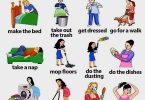Learning English communication through phrases and sentences is one of the simple but very effective ways that English learners should apply. “English greetings” is one of the most common topics in daily conversations. These sentences are used frequently and in each specific situation, there will be different usages.
Therefore, when learning these useful greeting expressions, you should examine thoroughly the context of use of each sentence to get the best use of them when communicating. Memorizing simultaneously all the greetings at one time is too difficult, so in each specific communicative situation, you should make efforts to use 1 to 2 suitable greetings.
Here are some of the most common and useful greetings in English that you can use in daily English communication.
I) English greetings for formal conversations
In English, formal greetings are used when interacting with others to be polite and show respect. It’s not necessary to use formal greetings with friends, family, classmates, and other people you know well, but you should use formal English when greeting people such as:
- Your boss, supervisor, manager, or any authority figure at work, unless the workplace norm is informal
- Authority figures in general, such as a judge or police officer
- Political figures, such as a member of congress or governor
- People in the service industry that you don’t know well, such as a waitress or hotel receptionist
- Your teacher or professor
- Someone you’re meeting for the first time
- Someone you don’t know very well or don’t see regularly
- Medical professionals, such as a doctor or nurse
- A religious leader, such as a priest, pastor, minister, or rabbi
It’s best to begin by using formal greetings in most business situations, and then listen to how your co-workers or business partners greet you. It’s a good idea to wait until someone speaks casually with you before you speak casually with them. You may find that people will begin to use casual greetings with you over time, as you get to know each other better. Formal greetings are also used when you meet older people.
Use the following salutation examples to start a formal conversation in any of these situations.
- Good morning, Good afternoon, or Good evening: The greetings good morning/good afternoon/good evening are used at different times of the day to greet people. “Good morning” is generally used from 5:00 a.m. to 12:00 p.m. whereas “Good afternoon” is appropriate for a period from 12:00 p.m. to 6:00 p.m. “Good evening” is often used after 6 p.m. or when the sun goes down.
Good morning, everyone, and welcome to Manchester! - It’s an honor to meet you: This is usually used when you meet someone important. This is a very formal greeting and it expresses respect.
“It’s an honor to meet you, madam“ - Pleased to meet you/ It’s been a pleasure meeting you: These greetings are formal and polite. If you say this to someone when you meet him or her for the first time, it will make you seem courteous. Remember to only use these greetings the first time you meet someone. Next time you see the person you can show that you remember him or her by saying “it’s nice to see you again”.
“It’s has been a great pleasure meeting you, Micah” - How do you do?: This is a formal greeting for someone that you have not met before
“I’m Jack Stewart.” “How do you do? I’m Angela Black.” - How have you been?: This greeting is similar to “How are you?” But “How have you been?” is used when you haven’t seen someone for a longer time, like several months or longer.
A: How have you been?
B: I’ve been busy working a lot. How about you? - I’m so happy to see you again: This sentence is used in a situation in which people have not met each other for a period of time.
A: Tracy, it has been a long time since the last time we met each other!
B: Yes, John. I’m so happy to see you again.
II) English Greetings for informal conversations
With colleagues you know well, clients you have developed a relationship with, or people who are acquaintances of yours (not close friends or family, but people you are friendly with), it is appropriate to be a little more relaxed with the language.
Example situations include:
- In the office with your team and colleagues
- Meeting or lunch with a regular client
- Networking events
- A trade show or job fair
- Conferences
- Greeting neighbors
- Seeing an acquaintance unexpectedly (for example, seeing someone you know at the grocery store or in a restaurant)
It is often also very common to shake hands with someone when you greet them. This is common for business contacts and acquaintances.
Use the following salutation examples to start an informal conversation in any of these situations.
- Hello / Hi / Hey: These are very common and appropriate to use in more informal situations. Most of the time, people include the person’s first name (English speakers tend to be more informal generally speaking). Hey should be reserved for people you know well. This is the most informal of these 3 greetings but it is definitely appropriate for people in your office you see every day and your close work colleagues.
Hi, Monica. Nice to see you! - How are you doing? / How’s it going?: This is a casual way of asking “How are you?” People prefer to ask one of these questions after the main greeting. Usually, it is followed by a brief, positive answer.
A: Hello, Amanda! How are you doing?
B: Fine, thanks. And you?
A: Hi, Michel. How’s it going?
B: Great! How about you? - Long-time no see. / It’s been a while. / When was the last time we saw each other?: These expressions are used when you have not seen someone for a long time. These are also great expressions to use to start a little small talk. The question “When was the last time we saw each other?” is an easy way to start a conversation about what has happened since you last saw each other.
“Long time no see Jenifer” - Good to see you. / It’s great to see you. / Nice to see you: You can use these expressions when you have not seen someone in a long time or when you see someone unexpectedly. For example, meeting a client for a lunch, seeing a business contact at a meeting or seeing an acquaintance at the grocery store.
“Well, it was great to see you. I have to get going. Have a good day. Goodbye.“ - How have you been? / How have things been going (since I last saw you)? / What have you been up to?: These questions are often used after an expression such as, “Long-time, no see” or “It’s been a while.” These are similar to asking “How are you?” and are great ways to start some small talk. The questions invite the person to say how they are doing or to share any new, interesting information they are comfortable sharing.
A: It’s been a while, Tracy. How have you been?
B: Nothing to complain about! The family is good and work is fine. Just the same old, same old. What about you?









Thanks, I liked it
You’re welcome 🙂